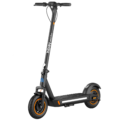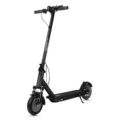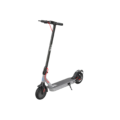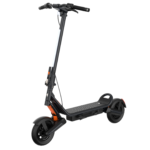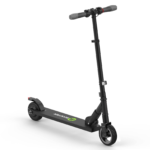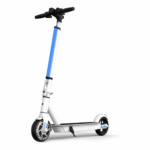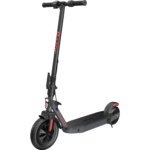- Home
- Scooters
- Electric Scooters
- Hiboy TITAN PRO
Hiboy TITAN PRO
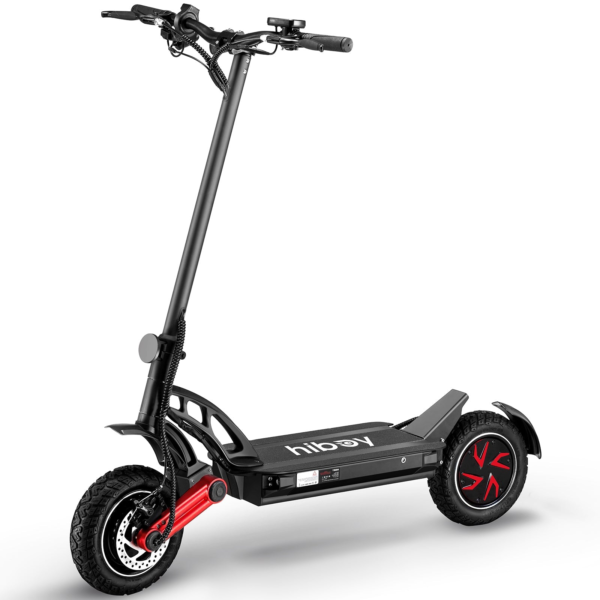

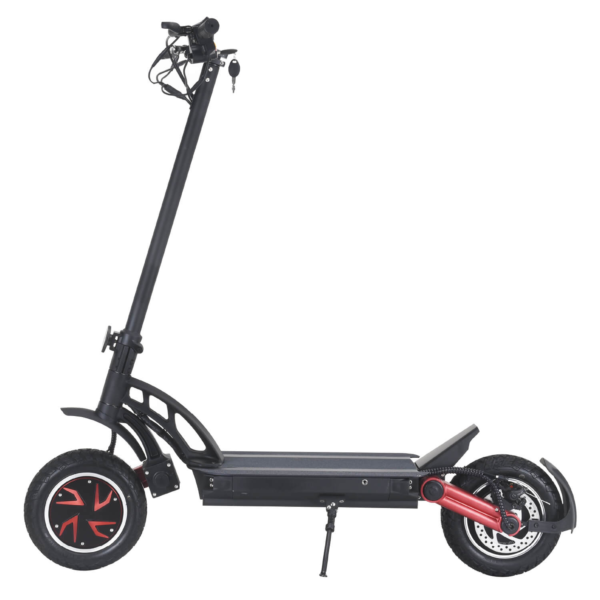
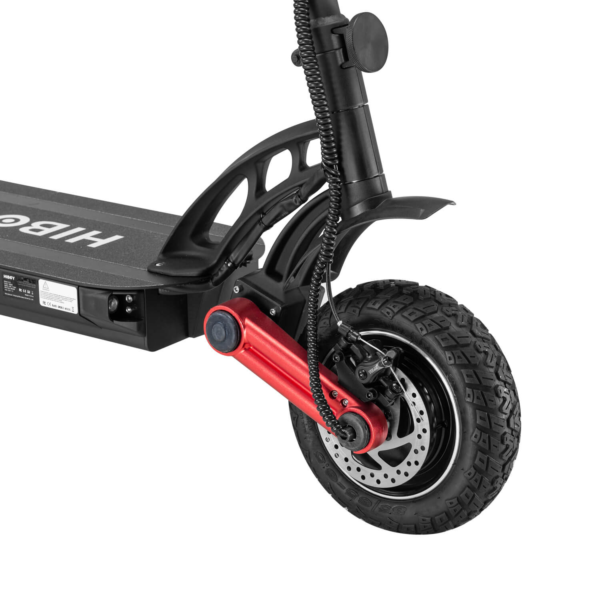
- Battery Range: 80 miles (129 km)
- Top Speed: 31 mph (50 km/h)
- Motor Power: Dual 750 W (peak 1000 W each)
- Weight Capacity: 330 lb (150 kg)
- Charging Time: ~12.5–13.5 h
- Scooter Weight: 103.6 lb (47.0 kg)
PROS
- Dual-motor 2WD
- Dual hydraulic disc brakes
- 48V 36Ah battery (1,728 Wh)
- Front & rear suspension
- 10″ gel-filled tubeless tires
CONS
- Very heavy to carry
- IP rating modest for off-road use (IPX4 body)
- Long charge time
Table of contents
- What Is the Hiboy TITAN PRO?
- How the Hiboy TITAN PRO Works
- Key Specifications
- Design & Build Quality
- Performance Fundamentals
- Battery, Range & Efficiency
- Ride Quality & Comfort
- Braking & Safety Features
- Portability & Daily Usability
- Maintenance & Care
- Weather & Seasonal Considerations
- Hiboy TITAN PRO vs Alternatives
- Who the Hiboy TITAN PRO Is (and Isn’t) For
- FAQs
- Glossary
- Final Thoughts
The Hiboy TITAN PRO is a dual-motor, off-road-leaning electric scooter for riders who want real power, long range, and stable handling without complexity. Consequently, it suits ambitious commuters and weekend explorers alike. Moreover, its wide deck, hydraulic brakes, and gel-filled tubeless tires combine to deliver control on rough streets and gravel paths. Ultimately, if you need balanced speed, stability, and durability, the Hiboy TITAN PRO is built for that brief.
What Is the Hiboy TITAN PRO?
At its core, the Hiboy TITAN PRO is a performance commuter with serious legs. It uses a reinforced aluminum frame, dual suspension, and 10-inch (25.4 cm) gel-filled tubeless tires to smooth sharp edges on imperfect surfaces. Additionally, two hub motors power the wheels, so you can choose single-motor efficiency for casual cruising or engage both motors for strong launches and hill work. As a result, the scooter adapts to city blocks, park loops, and hard-packed paths without drama.
Even so, it emphasizes control over flash. The cockpit is clear and functional, the lighting is bright, and the hydraulic brakes offer predictable stopping. Meanwhile, the large battery supports longer rides, and the folding stem keeps storage practical. Therefore, riders graduate from “first week cautious” to “confident daily” surprisingly fast.
How the Hiboy TITAN PRO Works
Motor. Two hub motors drive the wheels. In single-motor mode, the scooter sips energy and runs quietly. However, switch to dual-motor mode and the TITAN PRO surges off the line with authority, especially on mild grades. Think of it like toggling from eco to sport in a car; the hardware is the same, yet the power delivery changes.
Additionally, if you’re cross-shopping the base model, see the Hiboy TITAN for comparison.
Controller. The controller meters current from the battery to the motors according to throttle position and mode. Therefore, roll-ons feel smooth rather than jumpy. Furthermore, the controller monitors temperature and voltage, so output remains consistent across a ride, not just at the first mile.
Battery. A 48 V, 36 Ah lithium-ion pack (≈1728 Wh) sits low in the deck. Because mass is centered and low, the scooter tracks straight and feels planted at speed. In addition, a battery management system protects against over-charge, over-discharge, and over-current, which helps the pack age gracefully.
Throttle. The thumb throttle is progressive. Press lightly to match walking speed in crowds; press deeper to merge briskly when lanes open. Consequently, pace control is intuitive even for new riders.
Brakes. Front and rear hydraulic disc brakes provide firm initial bite with low lever effort. Moreover, electronic cutoffs reduce drive power the instant you brake, which shortens stopping distances and improves control on slippery surfaces.
Key Specifications
Imperial first, then metric in parentheses.
| Block | Details |
|---|---|
| General | Model: Hiboy TITAN PRO. Max load: 330 lb (150 kg). Net weight: 103.6 lb (≈47.0 kg). Tires: 10 in (25.4 cm) gel-filled tubeless. |
| Performance & Power | Drive: single / dual selectable. Rated motor power: 750 W × 2. Peak motor power: 1000 W × 2. Top speed: 31 mph (≈50 km/h). Max climbing: 35% grade. |
| Battery, Charging & Electrical | Battery: 48 V, 36 Ah (≈1728 Wh), Li-ion with BMS. Certification: UL2272 (battery). Charging: full charge from low typically overnight with standard charger. |
| Build & Dimensions | Frame: reinforced 6061 aluminum, front & rear suspension. Unfolded: 51.3 × 25.6 × 51.4 in (≈130.3 × 65.0 × 130.6 cm). Handlebar width: 25.2 in (64.0 cm). Deck length/width: 24.4 × 10.2 in (≈62.0 × 25.9 cm). Standing height: 40.9 in (104 cm). Folded height: 22.8 in (57.9 cm). |
| Safety & Control | Brakes: front & rear hydraulic discs with electronic cutoffs. Lighting: front and rear LEDs, ambient deck LEDs, horn. Display: 3.5 in color LED (speed, battery, voltage, trip, modes, cruise). Water resistance: Scooter IPX4, Battery IPX5. |
| Features & Extras | Mode switches (single/dual), multi-level speed modes, cruise control, loud horn, ambient lighting. |
| Warranty & Compliance | Limited warranty typical for the category; electrical safety: UL2272 battery. Local riding rules vary by region. |
Design & Build Quality
From the first walk-around, the TITAN PRO presents as sturdy and purposeful. The 6061 aluminum frame balances stiffness with weight, while tidy welds and even paint underline solid factory execution. Additionally, the deck’s low-mounted battery contributes to a low center of gravity, so the scooter resists pitching and stays composed over ripples.
Up at the bars, the cockpit is wide and uncluttered. The 3.5-inch color display sits central and remains readable in daylight. Meanwhile, the horn, light, cruise, and single/dual motor controls sit within easy reach, which reduces eyes-off-path time. Lock-on grips resist twisting under heavy braking, and cable routing avoids awkward kinks.
Down below, suspension components tame both chatter and larger hits. Because the spring rate ramps predictably, the scooter avoids harsh top-outs or bottom-outs when you cross curb lips or patched asphalt. Furthermore, the 10-inch gel-filled tubeless tires reduce flat risk and maintain shape under load, which steadies steering feedback at speed. Granted, gel-filled casings feel slightly firmer than fully pneumatic tires; however, the trade-off is fewer roadside repairs and steadier handling over debris.
Finally, the folding mechanism is direct and positive. It locks with a reassuring snap, yet it releases cleanly when you need to fold. As a result, storage in a trunk or under a desk is practical even though the scooter is heavy.
Performance Fundamentals
Acceleration feel. In single-motor mode, takeoffs are smooth and manageable for beginners. However, toggle to dual motors and the TITAN PRO delivers a strong, linear surge. Importantly, the front end stays planted, provided your stance is balanced and your arms are relaxed.
Cruising stability. Because the cockpit is wide and the wheelbase is generous, the chassis tracks straight at urban speeds. As velocity increases, correct tire pressures and an athletic stance preserve calm steering. Moreover, the long, grippy deck lets you offset your feet, which damps minor shimmy naturally.
Hill-climb behavior. On 7–10% grades, the scooter maintains pace confidently in dual-motor mode. Start smoothly, keep your weight neutral, and apply steady throttle. Consequently, traction stays consistent, and motor noise remains unobtrusive.
Battery, Range & Efficiency
Pack size and meaning. With 48 V × 36 Ah ≈ 1728 Wh, the TITAN PRO carries serious energy. In practice, watt-hours translate to potential miles; however, speed, weight, wind, and temperature shape the final number.
Rated vs real-world range. Under ideal conditions—mild weather, smooth roads, light rider, and modest speeds—range stretches impressively. Conversely, cold temperatures, headwinds, steep hills, or repeated maximum-throttle sprints shorten it noticeably. Therefore, moderate pacing yields the best miles per charge.
Rider weight and terrain. Heavier riders and coarse surfaces raise rolling resistance. Even so, efficient habits help: coast early toward intersections, use single-motor mode for flat sections, and avoid jackrabbit launches.
Charging best practices. Lithium-ion chemistry rewards gentle treatment. Consequently, avoid running the pack to empty as a routine. Instead, recharge around 20–30% remaining. For daily use, you can stop at 80–90% if that covers your next ride; then, perform an occasional full charge to allow cell balancing. After charging, let the pack rest a few minutes before hard riding. In storage, keep charge around 50–70% and park in a cool, dry place.
Efficiency tips. Keep tires properly inflated, ensure brake rotors are not rubbing, and select a middle speed mode for mixed city riding. Additionally, anticipate traffic so you can maintain momentum rather than cycle between full gas and full brakes.
Ride Quality & Comfort
The TITAN PRO’s comfort stems from three elements working together: tire volume, suspension, and mass distribution. First, the 10-inch gel-filled tubeless tires shrug off small debris and resist pinch flats. Next, the dual suspension filters both buzz and larger imperfections. Finally, the low battery placement settles the chassis over rough patches, so the deck remains calm under your feet.
Ergonomically, the handlebar width offers leverage without feeling ungainly in tight gaps. Meanwhile, the long deck supports a staggered stance, which lowers fatigue on longer rides. If you notice a hint of stem shimmy at higher speeds, drop your elbows, soften your knees, and shift your rear foot slightly aft; consequently, the front stabilizes and the wobble fades.
Admittedly, the TITAN PRO is not a featherweight. Nevertheless, its mass works in your favor when slicing through choppy pavement or gravelly corners. Because the chassis carries momentum, it tracks predictably and forgives small rider inputs, which reduces mental load on longer trips.
Braking & Safety Features
Hydraulic discs deliver a confident brake feel. Initial bite arrives early, and power builds progressively through the lever stroke. Therefore, you can trail brake into corners or stop assertively without sudden lockups on dry pavement. In the wet, begin your pull slightly earlier and keep weight centered to maintain traction.
Lighting aids visibility from multiple angles. A bright headlight projects forward, a rear light signals presence, and ambient deck LEDs add side awareness at night. Additionally, the horn is loud enough for busy paths. Water resistance is rated IPX4 for the scooter body and IPX5 for the battery enclosure. Consequently, the TITAN PRO tolerates showers and splashes, although deep standing water and pressure washing remain off limits. After wet rides, dry the scooter and check braking surfaces to restore bite.
The central display is clear in sunlight and concise at a glance. Speed, battery bars, voltage, trip, and mode indicators sit where your eyes expect them, so you refocus on the road quickly.
Portability & Daily Usability
At 103.6 lb (≈47.0 kg), the TITAN PRO is best rolled rather than carried far. Even so, the fold reduces height to 22.8 in (57.9 cm), which simplifies car transport and office storage. When lifting, use two hands and a neutral spine. If you live up multiple flights, consider a ground-level storage plan.
Daily operation rewards sensible mode choices. For crowded paths, select low speed and single-motor drive. For mixed city segments, choose a middle mode. Then, reserve full output for open stretches. Consequently, rides feel composed, and energy use stays reasonable.
For security, layer defenses: a quality U-lock or heavy chain through the frame, a cable through a wheel if possible, and parking in visible areas. Additionally, remove accessories when unattended, and disable ambient lights to reduce attention.
Maintenance & Care
Weekly quick-check (≈5 minutes).
• Tire condition and pressure. Moreover, look for cuts or embedded debris.
• Brake lever feel and rotor rub; pads should not drag.
• Fasteners at stem clamp, axle nuts, and fender mounts.
• Lights and horn function.
Monthly basics.
• Inspect brake pads; replace if thin or glazed.
• Clean rotors with isopropyl alcohol; consequently, bite returns.
• Verify suspension mounting torque.
• Examine tires for uneven wear; rotate if the front still looks new.
Every 3–6 months.
• Full fastener audit with a torque wrench—especially stem, latch, and deck bolts.
• Battery health check: compare usual route consumption to prior months; note any sudden changes.
• Firmware/app habits: if adjustable settings exist, document changes and effects; otherwise, keep defaults.
Battery care.
• Store at 50–70% if unused for weeks.
• Avoid heat; never leave in a hot car.
• Charge on a non-flammable surface with the original or approved charger.
Cleaning.
• Wipe with a damp cloth and mild soap.
• Avoid direct water jets at bearings, display, and charge port.
• Dry fully before charging.
With these routines, performance stays consistent while wear items last longer.
Weather & Seasonal Considerations
Rain. The IPX4/IPX5 protection helps in showers; however, traction still drops on painted lines, metal grates, and wet leaves. Reduce speed, lengthen following distance, and brake progressively. Afterwards, dry the scooter and wipe rotors to restore bite.
Heat. High ambient temperatures raise controller and battery temps. Consequently, avoid repeated top-speed runs in extreme heat. Park in shade when possible and allow the pack to cool before charging; heat is the enemy of cell longevity.
Cold. Near-freezing weather reduces available range. Therefore, start with a warm battery if you can, then ride at moderate speeds. Expect a meaningful decrease in miles per charge until temperatures rise again.
Dust and debris. On gravel or dusty paths, the gel-filled tubeless tires shine. Even so, dust can glaze pads; clean them periodically. In addition, check fender mounts and cable guides after rough rides.
Hiboy TITAN PRO vs Alternatives
Within the performance-commuter and light off-road bracket, the TITAN PRO distinguishes itself with dual motors, hydraulic discs, and gel-filled tubeless tires that reduce flat downtime. By contrast, compact city scooters favor low weight and effortless carry but sacrifice planted stability and heavy-duty brakes. Conversely, ultra-high-power scooters offer brutal acceleration yet demand more skill, more maintenance, and more storage space.
Therefore, if your route blends smooth pavement with patched sections, and if weekend loops sometimes venture onto gravel, the TITAN PRO hits a sensible middle ground. It is not the lightest tool for multi-modal commuters; nevertheless, it is the calmer, sturdier choice for riders who value speed with composure and fewer tire repairs.
Who the Hiboy TITAN PRO Is (and Isn’t) For
Great for:
• Medium-to-long commutes where stability, braking, and range matter.
• Suburban riders with park paths, canal trails, or hard-packed gravel.
• Students crossing large campuses with varied surfaces and mild hills.
• Recreational riders who want long weekend loops without charge anxiety.
• Heavier riders who benefit from strong frames and dual-motor traction.
Not ideal for:
• Multi-modal travelers who must shoulder a scooter up several flights daily.
• Riders with extremely tight storage who need ultra-compact, ultra-light platforms.
• People who prefer ultra-nimble, featherweight handling over planted stability.
FAQs
1) How fast does the Hiboy TITAN PRO go, and how stable is it at speed?
It reaches about 31 mph (≈50 km/h). With proper tire pressure and a balanced stance, the chassis tracks straight and remains composed. Moreover, the wide deck lets you brace comfortably, which reduces minor shimmy.
2) What range should I expect in the real world?
Range depends on speed, rider weight, temperature, wind, and terrain. At moderate speeds in mild weather, you’ll cover long distances. Conversely, cold, hills, or repeated sprints will trim miles.
3) Can the Hiboy TITAN PRO climb hills reliably?
Yes. In dual-motor mode, it handles typical city grades of 7–10% with steady throttle. As a result, it avoids bogging and maintains traction if your weight stays centered.
4) How does the braking feel day to day?
Hydraulic discs provide early bite and progressive power. Therefore, stops feel predictable, and lever effort remains low even on longer descents.
5) Is the Hiboy TITAN PRO usable in the rain?
It carries IPX4 body and IPX5 battery protection. Light showers are manageable; however, avoid deep standing water and pressure washing. Afterwards, dry the scooter and check brake surfaces.
6) Does it include cruise control and a clear display?
Yes. Cruise control helps on steady sections, and the 3.5-inch color display shows speed, battery, voltage, trip, and modes clearly.
7) Where can I get a concise Hiboy TITAN PRO overview?
Right here—this guide consolidates design, performance, range, comfort, safety, and care into a single Hiboy TITAN PRO overview for easy reference.
Glossary
Amp-hour (Ah): Battery capacity measure. Higher Ah usually means more potential distance.
Watt-hour (Wh): Energy measure (V × Ah). More Wh generally equals more range.
Controller: Electronics that regulate power to the motors; key to smooth acceleration.
Peak power: Short-duration output for hard acceleration; not sustained.
Rated power: Continuous motor output under normal conditions.
BMS (Battery Management System): Protection circuitry that improves safety and longevity.
Regenerative braking (regen): Motor-based slowing that may feed small energy back to the battery.
Stem flex: Slight bending or oscillation in the stem at speed or on bumps.
IP rating: Ingress Protection score for dust/water resistance; higher second digit indicates better water resistance.
Dual-motor mode: Both hub motors drive for stronger launches and hill holding.
Single-motor mode: One motor drives for better efficiency and quieter cruising.
Torque: Rotational force from the motors, crucial for starts and hills.
Grade: Hill steepness; 10% means a 10 m rise over 100 m horizontal.
Tubeless tire: Tire that seals to the rim without an inner tube; often better puncture management.
UL2272: Electrical safety certification relevant to rideables’ battery systems.
Final Thoughts
In sum, the Hiboy TITAN PRO blends substantial battery capacity, dual-motor thrust, and hydraulic stopping power into a chassis that remains calm at speed and forgiving over rough pavement. Additionally, gel-filled tubeless tires reduce flat interruptions, while the wide deck and clear controls make daily riding straightforward. Admittedly, weight limits easy carry; however, the fold keeps storage manageable, and the stability dividend is obvious once you’re rolling.
Therefore, if your weekly rides mix smooth streets with patched sections—and if your weekends sometimes wander off asphalt—the Hiboy TITAN PRO offers practical speed, reliable range, and confident control for the long haul.
Specifications
General
| Model The Model specifies the exact version or name of the scooter. It helps identify its unique design, features, and specifications within the manufacturer’s product line. Knowing the model makes it easier to compare options, find compatible accessories, or look up support information. | TITAN PRO |
| Brand The Brand identifies the manufacturer or company that designs and produces the scooter. A trusted brand is a sign of quality, reliability, and good customer support. Well-known brands often have higher standards for safety, performance, and after-sales service, giving you more confidence in your purchase. | Hiboy |
| Release Date The Release Date indicates when the scooter model was officially launched on the market. This helps you know how current the design, technology, and features are. A newer release date often means updated components, improved performance, and the latest safety or smart features. | 17 November 2025 |
| Recommended Age Recommended Age indicates the minimum age range that the scooter is designed for, based on safety, size, and ease of use. Following the recommended age helps ensure that riders can handle the scooter’s speed, weight, and controls comfortably and safely. Always check local laws and use protective gear, especially for younger riders. | +16 |
Performance & Power
| Motor Power (Wattage) What it means: The motor power, measured in watts (W), shows how strong the scooter’s electric motor is. Why it matters: Higher wattage usually means better acceleration, more torque, and improved performance on hills or rough terrain. For example, a 250W motor is good for flat city roads and light riders, while a 500W or 1000W motor provides more power for faster speeds or climbing steep inclines. | Dual hub motors, 750 W rated each (1000 W peak each) |
| Top Speed The Top Speed indicates the maximum speed that the scooter can reach under optimal conditions. It’s usually measured on level ground with a fully charged battery and an average rider weight. A higher top speed allows you to travel longer distances faster, but always ensure you ride within legal speed limits and your personal comfort zone for safety. | 31 mph (50 km/h) |
| Battery Capacity Battery Capacity refers to the total amount of energy the scooter’s battery can store, usually measured in ampere-hours (Ah) or watt-hours (Wh). A higher battery capacity means you can ride longer distances on a single charge, reducing the need for frequent recharging. Keep in mind that actual range can vary depending on rider weight, terrain, speed, and weather conditions. | 48 V 36 Ah (1,728 Wh) |
| Estimated Range per Charge The Estimated Range per Charge indicates the average distance the scooter can travel on a single full battery charge. This range is calculated under optimal conditions, such as flat terrain, moderate speed, and average rider weight. Real-world range may vary depending on riding style, terrain, weather, and load. A longer range means fewer recharges and greater freedom for longer trips. | 80 miles (129 km) |
| Hill Climb Ability Hill Climb Ability describes the maximum incline or slope that the scooter can handle while maintaining stable performance. It’s typically expressed as a percentage or in degrees. A higher hill climb rating means the scooter can tackle steeper hills without losing too much speed or power. Actual climbing performance may vary based on rider weight, battery charge, and terrain conditions. | 35% |
| Drive System The Drive System refers to how power from the motor is delivered to the wheels. Electric scooters typically use either a hub motor (directly integrated into the wheel) or a chain/belt drive system. A high-quality drive system ensures smooth acceleration, efficient power transfer, and low maintenance. The choice of drive system affects performance, noise level, and overall ride experience. | 2WD |
Charging & Electrical
| Charging Time Charging Time indicates how long it takes to fully recharge the scooter’s battery from empty to 100% using the standard charger provided. Faster charging means less downtime and more time on the road. Actual charging time may vary slightly depending on battery capacity, charger output, and environmental conditions. | 12.5–13.5 hours |
| Battery Type Battery Type refers to the specific technology used in the scooter’s battery, which affects performance, lifespan, weight, and charging time. Most modern electric scooters use high-quality lithium-ion (Li-ion) batteries because they offer a good balance of energy density, durability, and low maintenance. A reliable battery type ensures consistent power delivery and longer riding ranges. | Lithium-ion (21700 cells) with BMS |
| Removable Battery A Removable Battery means the battery pack can be easily detached from the scooter for convenient charging and replacement. This feature allows you to charge the battery separately, swap it with a spare for extended range, or securely store it indoors in extreme weather. Removable batteries add flexibility and make it easier to keep your scooter powered up wherever you are. | No |
| Regenerative Braking Regenerative Braking is an energy-saving feature that converts some of the energy normally lost during braking back into battery power. When you slow down or brake, the motor works in reverse to generate electricity, which helps extend the scooter’s range and improves overall efficiency. This system also reduces wear on traditional brake components, leading to lower maintenance over time. | Not specified |
| Lighting Lighting refers to the built-in front and rear lights that enhance visibility and safety when riding in low-light conditions or at night. Good lighting helps you see the road ahead and ensures that other road users can see you. Many scooters include LED headlights, taillights, and sometimes brake lights or side reflectors for added safety and compliance with local traffic regulations. | Headlight, brake taillight, ambient lighting |
Build & Dimensions
| Scooter Weight Scooter Weight refers to the total weight of the scooter when fully assembled, including the battery. This affects how easy it is to carry, lift, and store the scooter when not in use. A lighter scooter is more portable and convenient for commuting, especially if you need to carry it upstairs or onto public transport. Keep in mind that a sturdy frame and quality components may add to the weight but also contribute to better durability and ride stability. | 103.6 lb (47.0 kg) |
| Maximum Rider Weight Maximum Rider Weight indicates the highest rider weight that the scooter is designed to safely support while maintaining optimal performance and stability. Staying within this limit helps ensure reliable acceleration, braking, and climbing ability, and it protects the frame, suspension, and motor from excessive strain. Exceeding the recommended limit may reduce performance and increase wear on components. | 330 lb (150 kg) |
| Deck Size Deck Size refers to the dimensions of the scooter’s standing platform. A wider and longer deck provides more foot space, allowing you to stand comfortably and adjust your stance while riding. A well-sized deck improves balance and stability, especially on longer rides or at higher speeds. Compact decks, on the other hand, help keep the scooter lightweight and portable. | Reinforced 6061 aluminum frame; off-road capable geometry |
| Handlebar Height Handlebar Height refers to the distance from the deck to the handlebars, which affects your riding posture and comfort. An appropriate handlebar height helps you maintain good balance, reduces strain on your back and arms, and makes steering more comfortable. Some scooters have adjustable handlebars to fit riders of different heights, while others have a fixed height for a streamlined design. | Fixed; overall height 50.0 in |
| Folding Mechanism The Folding Mechanism describes how easily and securely the scooter can be folded for carrying and storage. A well-designed folding system lets you quickly collapse the scooter into a compact size, making it convenient to transport on public transit, store under a desk, or fit into a car trunk. Look for sturdy latches and safety locks to ensure the scooter stays firmly in place when folded or unfolded. | Folding stem latch |
| Dimensions Folded Dimensions indicate the size of the scooter when it’s fully folded. This measurement shows how much space the scooter will take up when stored or carried, making it easier to check if it will fit in your car trunk, under a desk, or in a closet. Compact folded dimensions are ideal for commuters who need to bring their scooter on public transport or store it in tight spaces. | Unfolded: 51.3 × 25.6 × 51.4 in; Folded height: 22.8 in (other folded dims not specified) |
| Material Material refers to the primary construction materials used for the scooter’s frame and key components. High-quality materials like aircraft-grade aluminum, reinforced steel, or durable composites provide strength, stability, and a lighter overall weight. A sturdy material ensures the scooter can handle daily wear and tear while maintaining safety and performance. | 6061 aluminum |
Safety & Control
| Brake Type(s) Brake Type(s) describe the braking systems the scooter uses to help you slow down or stop safely. Common brake types include mechanical brakes (like drum or disc brakes), electronic brakes, and foot brakes. Many scooters combine multiple braking systems for added safety and shorter stopping distances. The type and quality of brakes affect your control, especially when riding at higher speeds or on slopes. | Front & rear hydraulic disc brakes |
| Suspension Suspension refers to the system that absorbs shocks and vibrations while riding, providing a smoother and more comfortable ride over uneven or rough surfaces. Scooters may have front suspension, rear suspension, or dual suspension for better shock absorption and stability. Good suspension helps reduce rider fatigue and improves control, especially when riding on bumpy roads or off-road paths. | Front & rear suspension |
| Tire Type Tire Type refers to the kind of tires the scooter uses, which directly affects ride comfort, traction, and maintenance. Common types include solid (airless) tires, pneumatic (air-filled) tires, or hybrid options. Pneumatic tires offer better shock absorption and a smoother ride on rough surfaces, while solid tires are puncture-proof and require less upkeep. The right tire type helps ensure safe handling and a comfortable ride in different conditions. | 10″ gel-filled tubeless tires |
| Tire Size Tire Size indicates the diameter and width of the scooter’s tires, which affect ride comfort, stability, and how well the scooter handles different terrains. Larger tires generally offer better shock absorption and a smoother ride over bumps and rough surfaces, while smaller tires keep the scooter lighter and more portable. Choosing the right tire size helps ensure a balance between agility and comfort. | 10-inch |
| Kickstand The Kickstand is a built-in stand that allows you to park your scooter upright when it’s not in use. A sturdy kickstand keeps the scooter stable and prevents it from tipping over, protecting it from scratches and damage. It also makes storing and accessing your scooter more convenient, whether you’re at home, work, or on the go. | Side kickstand |
| Water Resistance Rating Water Resistance Rating indicates how well the scooter is protected against water and moisture, usually shown as an IP (Ingress Protection) rating. This rating helps you understand whether the scooter can handle light rain, splashes, or wet roads without damage. While most scooters are not fully waterproof, a good water resistance rating adds peace of mind when riding in changing weather conditions. Always avoid deep puddles or submerging the scooter to protect its electrical components. | IPX4 (battery IPX5) |
Features & Extras
| Display/Console The Display (or Console) shows important real-time information about your ride, helping you monitor your scooter’s status at a glance. Typical displays show speed, battery level, distance traveled, and riding mode. Some models also include additional features like Bluetooth connectivity, app integration, or backlighting for better visibility at night. A clear and easy-to-read display enhances safety and convenience on every trip. | 3.5″ LED display |
| Ride Modes Ride Modes refer to the different speed and power settings you can choose to match your riding style or road conditions. Common modes include eco for maximum range and energy efficiency, standard for everyday balance, and sport or turbo for higher speed and stronger acceleration. Switching between ride modes allows you to customize performance, conserve battery, and ride safely in various environments. | Multiple speed levels; single/dual drive switch |
| Smart App Connectivity Smart App Connectivity lets you pair your scooter with a dedicated mobile app via Bluetooth. Using the app, you can monitor real-time ride stats like speed, battery level, and range, adjust settings such as ride modes or cruise control, lock the scooter for added security, and sometimes receive firmware updates. This feature adds convenience and allows you to personalize your riding experience right from your smartphone. | No app (not listed) |
| Anti-Theft System The Anti-Theft System helps protect your scooter from unauthorized use or theft. This feature can include built-in alarms, electronic motor locks, GPS tracking, or remote locking through a mobile app. A good anti-theft system provides peace of mind when parking your scooter in public spaces, adding an extra layer of security to safeguard your investment. | Not specified |
| Cruise Control Cruise Control allows you to maintain a steady speed without continuously holding the throttle. This feature makes longer rides more comfortable by reducing hand fatigue and providing a smoother, more relaxed riding experience — especially on flat, open roads or bike lanes. For safety, cruise control can usually be easily activated or deactivated while riding. | Yes (cruise control) |
| Accessories Included Accessories Included lists the additional items that come with the scooter to enhance your riding experience and convenience. Common accessories may include a charger, kickstand, bell, lights, phone holder, or carrying strap. These extras add value by making your scooter safer, easier to use, and ready to ride straight out of the box. | Scooter, charger (67.2V 2A), manual |
Warranty & Compliance
| Warranty Period The Warranty Period indicates how long the manufacturer guarantees the scooter against defects in materials and workmanship under normal use. A good warranty provides peace of mind, showing the brand’s confidence in its product quality. Always check what parts are covered, such as the frame, battery, and motor, and follow the maintenance guidelines to keep your warranty valid. | 12 months (region-dependent) |
| Certifications Certifications confirm that the scooter meets specific safety, quality, and environmental standards set by recognized organizations or regulatory bodies. Common certifications may include CE, RoHS, UL, or other local compliance marks, depending on your region. These certifications ensure that the scooter is manufactured to high standards and is safe and legal to use in your country. | UL2272 for battery (stated), region-dependent |


